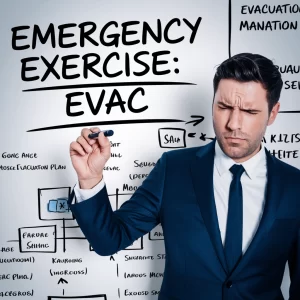Childcare services are essential community assets that provide care and learning opportunities for young children, offering parents peace of mind while they manage work and other responsibilities. However, beyond day-to-day operations, one of the most critical responsibilities for any childcare provider is ensuring that your service is fully prepared for emergencies, including natural disasters or other crises that can disrupt your operations.
I’ve taken the time to comprehensively review the Child Care Subsidy (CCS) arrangements that apply during emergencies, so you don’t have to. By summarising all the key information here, I’m saving you the hours of research and helping you take immediate, proactive steps.
This article helps you cut through bureaucratic red tape and focus on practical, actionable steps to ensure your centre continues to operate smoothly, even in the face of a crisis.
In Australia, the Department of Education has clear requirements for disaster-related administration that all childcare providers must follow. By being proactive and understanding these guidelines now, you can prevent operational disruptions later and ensure your centre remains a trusted source of support for families during and after emergencies.
Below, we’ll walk through how to effectively set up your childcare centre to handle disaster-related administration and how to stay compliant with CCS regulations during emergency situations.
By investing a few minutes now, you can save yourself significant time, stress, and potential disruption down the road.
Understanding the Importance of Disaster Preparedness for Childcare Services
Emergencies can happen without warning, whether they are bushfires, floods, severe storms, or other unexpected crises. The impact of these events can be profound, not only on the physical infrastructure of your childcare centre but also on its ability to continue operating. Childcare providers need to ensure their service is not only resilient but also compliant with federal and state requirements related to childcare subsidies and emergency protocols.
The Australian Department of Education requires childcare centres to follow specific administrative steps during emergencies to ensure families continue to receive financial support and children have safe care environments. Preparing your centre now means you’re less likely to be caught off-guard when a disaster strikes, and you can offer reassurance to your community by acting as a source of reliable information.
Child Care Subsidy (CCS) and Periods of Emergency
A key aspect of emergency preparedness is understanding how the Child Care Subsidy (CCS) operates during a disaster. The CCS is a government initiative that helps families offset the cost of childcare. In the event of a major weather event or other significant emergencies, the Department of Education may declare a CCS period of emergency.
This can happen if an emergency affects a widespread area, significantly impacts people’s lives, and makes it unsafe or impossible for children to attend a childcare service. During such periods, families and services in affected areas receive specific supports to help mitigate the disruption caused by the disaster.
Keeping Your Contact Information Up to Date
One of the most straightforward yet critical steps to ensure your childcare is ready for emergencies is to keep your contact details—especially email addresses—current in the Child Care Subsidy System or Provider Entry Point (PEP). The Department of Education uses this information to notify providers when a CCS period of emergency is declared. Without up-to-date contact information, your centre may miss important announcements or updates that directly affect your operations.
Updating your details in the Child Care Subsidy System is simple but can make a big difference when it comes to receiving timely information and support during an emergency.
Waiving Gap Fees During a CCS Period of Emergency
Another important administrative consideration during emergencies is the waiving of gap fees. Gap fees refer to the portion of childcare costs that families must pay out of pocket after receiving the CCS. During a CCS period of emergency, you can waive the gap fees for families if:
- The child does not attend care because of the emergency.
- Your service is closed as a direct result of the emergency.
This waiver provides financial relief for families affected by the disaster, ensuring that they are not burdened by childcare costs they cannot afford during such a challenging time.
Childcare centres can proactively communicate to families about the available options, including the waiver of gap fees during a CCS period of emergency. By informing parents early on, centres can provide immediate financial relief to families affected by the disaster, ensuring they aren’t overwhelmed by childcare costs during such a difficult time. This proactive approach not only reduces stress for families but also shows your commitment to supporting the community. By highlighting your ability to waive gap fees when children are unable to attend, you demonstrate leadership and care, reinforcing trust and loyalty among the families you serve. This strategy can enhance your centre’s reputation as compassionate, transparent, and supportive, strengthening long-term relationships and solidifying your role as a dependable resource in times of crisis.
Handling Allowable Absences During Emergencies
Childcare providers should also be aware of how allowable absences are handled during a CCS period of emergency. Normally, families have a limited number of allowable absences for the year. However, during an emergency, families in affected regions are granted extra allowable absences for the duration of the CCS period of emergency.
The Department of Education automatically applies these emergency absences in the Child Care Subsidy System, so providers don’t need to manually track these additional days. This helps families avoid losing their childcare spots or being penalized for missed days due to the emergency.
Childcare centres should proactively inform families about the automatic application of emergency absences in the Child Care Subsidy System during a CCS period of emergency. By letting families know that these absences are automatically recorded, centres can reassure parents that they won’t lose their childcare spots or be penalised for missed days due to the emergency.
This proactive communication alleviates concerns, helping families focus on staying safe without the added worry of managing administrative details. It also highlights the centre’s role in guiding families through the process, further strengthening trust and positioning the centre as a reliable and supportive partner during challenging times.
Navigating the 14-Week Rule During Emergencies
It’s important to remember that Family Assistance Law provisions still apply during emergencies. One of these is the 14-week rule, which states that a child’s enrolment will be automatically cancelled if they do not attend care for 14 consecutive weeks. However, in special circumstances, such as an approved absence due to a prolonged emergency, providers can apply for an exception to this rule.
Taking on Displaced Children During a Disaster
Emergencies often displace children from their regular childcare services, especially if those services are severely affected or destroyed. If your centre remains operational during a CCS period of emergency, you have the option to take on displaced children from other services. These children will be treated like any other enrolled child for CCS payments. However, it’s important to ensure that you do not exceed your licensed number of places when accepting displaced children.
It’s a good idea to partner with nearby providers so you can take on displaced children when needed. Having a partnership in place reassures your families that their children will have alternative care options if your operations are impacted, while also giving you the opportunity to support more families in the community and enhance your centre’s reputation as a trusted, collaborative provider during emergencies.
Communicating Closures to the Department of Education and Regulatory Authorities
If your service is temporarily closed due to a disaster, it’s crucial to communicate this information to the Department of Education and any relevant regulatory bodies, such as the NSW Early Childhood Education and Care Regulatory Authority.
Closure notifications should be submitted using the Provider Entry Point or your third-party software. This ensures that the Department of Education is aware of your status and can continue processing your CCS payments if your closure is directly related to the emergency. Keeping these authorities informed also ensures that you remain in compliance with all relevant legal and regulatory requirements.
Accessing the Special Circumstances Grant After a Disaster
In some cases, a disaster may cause severe financial strain on your childcare centre, potentially putting your long-term viability at risk. The Department of Education offers a Special Circumstances Grant for services in disadvantaged or vulnerable communities that are at risk of closure due to local emergencies.
This grant is available for childcare centres that are CCS-approved and face financial viability issues as a direct result of an emergency. The funding can help your service remain open and continue providing care to children in your community. If your cenrer meets the eligibility criteria, applying for the Special Circumstances Grant can provide vital support during the recovery period.
Ensuring Your Childcare is Best Set Up to Handle Disaster Administration
To successfully manage your childcare service through a disaster, it’s essential to have a robust administrative system in place. This means staying informed about the latest requirements from the Department of Education, ensuring your contact details are up to date, and being prepared to quickly implement emergency protocols when necessary.
The CCS period of emergency offers a range of supports to both families and childcare providers, helping to alleviate the financial and operational burdens that can arise during a crisis. By understanding these provisions, your childcare centre can continue to function smoothly and provide critical care to children and families when they need it most.
Get Expert Emergency Advice
Emergencies pose significant challenges for childcare centres, but with the right preparations, your service can navigate these situations smoothly. By staying informed, maintaining up-to-date contact details, and leveraging the supports available through the CCS system, your centre can continue to provide much-needed care to children and families during times of crisis. However, effective disaster preparation goes beyond compliance—it requires expert guidance and strategic planning to ensure your centre is truly ready to handle any situation.
That’s where Emertrix comes in. As a team of experienced emergency managers who have worked through some of New South Wales’ most devastating disasters, Emertrix provides unparalleled expertise in both the immediate response phase and the long-term recovery and reconstruction process. We have first-hand experience managing crises ranging from severe weather events to widespread emergencies.
Emertrix offers free consultations for all childcare providers, giving you the opportunity to evaluate your current disaster plans, identify potential gaps, and implement strategies that will keep your service operational even under the most challenging circumstances.
If you want to ensure your centre is fully prepared for any emergency, talk to Emertrix today. A proactive approach can make all the difference in how well your centre navigates a crisis and supports its community through recovery.
Frequently Asked Questions
How do I know if a CCS period of emergency has been declared?
The Department of Education will notify you via email or through the Child Care Subsidy System if a CCS period of emergency is declared. Ensure your contact details are always up to date in the system.
Can I take on children displaced from other centers during a disaster?
Yes, during a CCS period of emergency, you can enrol displaced children as long as you do not exceed your licensed number of places.
What happens if I need to close my service temporarily during an emergency?
You must notify the Department of Education and any relevant regulatory authorities, such as the NSW Early Childhood Education and Care Regulatory Authority, if you close your service due to an emergency. You can do this through the Provider Entry Point or third-party software.
Will I continue to receive CCS payments if my service closes during an emergency?
Yes, during a CCS period of emergency, you will continue to receive CCS payments if your closure is a direct result of the emergency.
What is the Special Circumstances Grant, and how can it help my service?
The Special Circumstances Grant provides financial assistance to CCS-approved childcare centres in disadvantaged or vulnerable communities that are at risk of closure due to a local emergency. It helps ensure that services can remain open during and after the crisis.
Can families get additional absences during a CCS period of emergency?
Yes, families in affected regions are granted additional allowable absences during a CCS period of emergency, and these are automatically applied in the Child Care Subsidy System.






